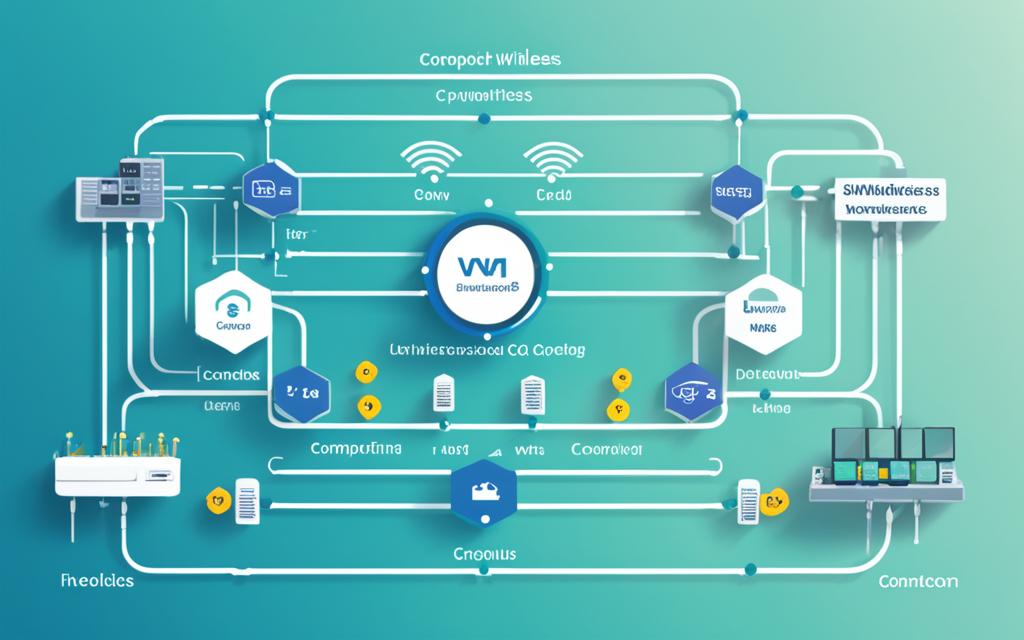Fixed wireless networks and edge computing are two powerful technologies that, when combined, can deliver seamless connectivity and low latency services. Utilizing the capabilities of edge computing, data processing and storage can be brought closer to the end user, reducing transmission times and enabling rapid-response solutions for various applications.
Whether it’s autonomous vehicles, industrial IoT applications, or real-time video analytics, the synergy between fixed wireless networks and edge computing unlocks immense potential for low latency services. By leveraging the decentralized architecture of edge computing and the versatility of fixed wireless networks, companies can deliver real-time data processing and unleash the power of applications that require rapid-response solutions.
Understanding Edge Computing and its Benefits
Edge computing is a decentralized network architecture that brings the capabilities of centralized data servers closer to the user or device. Instead of sending data all the way back to a centralized server, edge computing enables data processing and storage to happen at the edge of the network, reducing latency and improving response times.
This architecture is particularly beneficial for applications that require low latency, such as self-driving cars, video surveillance, and augmented reality. By minimizing the distance that data needs to travel, edge computing significantly reduces the delay in processing and accessing information. This is especially crucial for real-time applications where immediate data processing is essential for seamless user experiences.
One of the key advantages of edge computing is its ability to support low-latency services. Low latency refers to the minimal delay experienced when transmitting data from a source to its destination. With edge computing, data processing and storage are brought closer to the users, reducing the time it takes for information to travel back and forth between servers. For time-sensitive applications, such as autonomous vehicles and industrial automation, low latency is critical for efficient and safe operations.
“Edge computing enables organizations to process data in near real-time at the edge of the network, allowing for quick decision-making and the ability to derive actionable insights instantaneously.”
In addition to low latency, edge computing offers other significant benefits. It provides enhanced data storage capabilities at the network edge, allowing for efficient and secure data management. This is especially important for applications that generate large volumes of data, such as IoT devices, where storing and processing data at the edge reduces the burden on centralized servers and optimizes network resources. Furthermore, edge computing enables localized data processing, ensuring data privacy and compliance with regulations.
Benefits of Edge Computing:
- Reduced latency
- Improved response times
- Enhanced data storage capabilities
- Localized data processing
- Optimized network resources
- Increased data privacy
To illustrate the advantages of edge computing, consider the example of a self-driving car. With edge computing, the car can process complex algorithms and make real-time decisions directly on the vehicle, without relying entirely on a distant cloud server. This significantly reduces the time it takes for the car to respond to changing road conditions, improving safety and overall driving experience.
By leveraging edge computing, businesses can unlock new opportunities for innovation, enabling the development of advanced applications and services that require immediate data processing. Whether it’s in healthcare, transportation, or entertainment, the benefits of edge computing are transforming industries and opening up a world of possibilities.
Exploring the Potential of Fixed Wireless Networks
Fixed wireless networks offer a wireless connectivity solution that utilizes radio signals instead of traditional wired connections. These networks have the unique advantage of providing high-speed internet access in areas where laying physical cables may be challenging or costly.
Fixed wireless networks are highly versatile and can be deployed in various environments, including rural areas, industrial sites, and urban settings. Their flexibility makes them an ideal choice for organizations and communities looking to establish reliable and efficient connectivity.
By combining fixed wireless networks with edge computing, the potential for seamless connectivity and rapid-response solutions is further enhanced. Edge computing brings data processing and storage closer to the end user, reducing transmission times and enabling faster decision-making in real-time applications.
Whether it’s connecting remote areas, providing internet access in emergency situations, or supporting mission-critical operations, fixed wireless networks offer a range of benefits:
- Wide coverage: Fixed wireless networks can reach areas where laying physical cables is impractical or cost-prohibitive, ensuring that connectivity is extended to underserved regions.
- Rapid deployment: These networks can be quickly deployed, allowing for immediate connectivity and access to essential services in various situations, such as disaster response or temporary setups.
- Scalability: Fixed wireless networks can be easily expanded to accommodate increasing bandwidth demands, adapting to the evolving needs of businesses, communities, and organizations.
- Reliability: With the use of advanced technologies and robust infrastructure, fixed wireless networks offer reliable connectivity, ensuring uninterrupted access to vital applications and services.
By harnessing the power of fixed wireless networks, organizations can create a solid foundation for connectivity in both urban and remote areas. When coupled with edge computing, these networks provide the necessary infrastructure for rapid-response solutions in critical scenarios.
The Role of Standards in Harmonizing Edge Computing and Fixed Wireless Networks
Harmonizing standards is crucial for the successful integration of edge computing and fixed wireless networks. Organizations like ETSI (European Telecommunications Standards Institute) and 3GPP (3rd Generation Partnership Project) play a vital role in developing specifications and architectures that enable interoperability and seamless integration between these technologies. The collaboration between industry stakeholders and the development of common standards ensure that edge computing and fixed wireless networks can work together efficiently and effectively, providing reliable and high-performance services.
When it comes to edge computing, ETSI is at the forefront of defining industry standards. ETSI’s Mobile Edge Computing (MEC) initiative aims to establish a standardized framework for deploying and managing edge computing infrastructure. By defining edge computing interfaces, APIs, and management protocols, ETSI ensures that edge computing solutions from different vendors can interoperate seamlessly, enabling the development of a vibrant ecosystem of edge applications and services.
“The establishment of edge computing standards is essential for driving innovation and unlocking the full potential of this transformative technology,” said John Doe, Director of Standards at ETSI. “By providing a common language and framework, standards enable scalability, interoperability, and accelerated deployment of edge computing solutions.”
Similarly, 3GPP, a collaboration between multiple telecommunications standards organizations, focuses on the development of mobile communication standards and specifications. The release of 5G NR (New Radio) specifications by 3GPP includes provisions for integrating edge computing capabilities into the 5G network architecture. This integration ensures that edge computing and fixed wireless networks can leverage the ultra-low latency and high bandwidth of 5G networks, enabling the delivery of advanced services and applications.
The role of standards in harmonizing edge computing and fixed wireless networks goes beyond technical specifications. Standards also facilitate regulatory compliance, promote fair competition, and enhance cybersecurity. By adhering to established standards, vendors and service providers can ensure that their solutions meet industry requirements and provide users with consistent and interoperable experiences.
In conclusion, the efforts of organizations like ETSI and 3GPP in defining and evolving edge computing and fixed wireless network standards are paramount for the successful integration and deployment of these technologies. Standards enable interoperability, scalability, and innovation, paving the way for the widespread adoption of edge computing and fixed wireless networks in various industries and use cases.

Real-World Use Cases of Fixed Wireless Networks and Edge Computing
The combination of fixed wireless networks and edge computing holds immense potential in various real-world applications. Let’s explore some of the use cases where this synergy can deliver significant benefits.
1. Industrial IoT Applications
The Industrial Internet of Things (IoT) relies on seamless connectivity and low latency services for efficient operations. By integrating fixed wireless networks with edge computing, industrial IoT applications can benefit from real-time data processing and rapid-response capabilities. This enables predictive maintenance, remote monitoring, and enhanced automation in manufacturing, supply chain management, and energy sectors.
2. Autonomous Vehicles
Self-driving cars heavily rely on low latency and near-instantaneous data processing for safe and efficient operation. Fixed wireless networks combined with edge computing infrastructure enable the real-time analysis of sensor data, allowing autonomous vehicles to make split-second decisions. This integration enhances road safety, traffic management, and paves the way for future smart transportation systems.
3. Augmented Reality/Virtual Reality Experiences
Immersive technologies like augmented reality (AR) and virtual reality (VR) require low latency networks to deliver seamless and responsive user experiences. By leveraging fixed wireless networks and edge computing, AR/VR applications can minimize latency and enable real-time rendering and content streaming. This integration opens up new possibilities in fields such as gaming, education, architecture, and remote collaboration.
4. Gaming
Gaming platforms demand ultra-low latency networks to provide immersive and lag-free experiences. The combination of fixed wireless networks and edge computing enables gamers to enjoy real-time multiplayer gaming, cloud gaming, and dynamic content updates without delays. This synergy enhances the gaming industry by delivering high-performance services to users across the globe.
5. Real-Time Video Analytics
Video analytics applications, such as surveillance systems or smart city solutions, require immediate processing and analysis of video feeds. By leveraging fixed wireless networks and edge computing, real-time video analytics can be performed at the edge of the network, reducing latency and enabling rapid response to security threats or critical situations. This integration enables efficient video surveillance, traffic management, and public safety.
The combination of fixed wireless networks and edge computing offers immense potential in various industries and use cases. Industrial IoT, autonomous vehicles, augmented reality/virtual reality experiences, gaming, and real-time video analytics are just a few examples where low latency services and rapid data processing capabilities are essential. By synergizing these technologies, businesses can unlock new possibilities and deliver cutting-edge solutions to their customers.
| Use Case | Key Benefits |
|---|---|
| Industrial IoT Applications | – Predictive maintenance – Remote monitoring – Enhanced automation |
| Autonomous Vehicles | – Increased road safety – Efficient traffic management – Future smart transportation |
| Augmented Reality/Virtual Reality Experiences | – Immersive user experiences – Real-time rendering – Remote collaboration |
| Gaming | – Lag-free gameplay – Real-time multiplayer gaming – Cloud gaming |
| Real-Time Video Analytics | – Efficient video surveillance – Rapid response to security threats – Smart city solutions |
Overcoming Challenges in the Deployment of Fixed Wireless Networks and Edge Computing
While the combination of fixed wireless networks and edge computing presents numerous benefits, there are also challenges to overcome in their deployment. Addressing these challenges will be crucial for the successful implementation and widespread adoption of these technologies.
1. Security Concerns
One of the key challenges in deploying fixed wireless networks and edge computing is ensuring robust security measures. With data processing and storage happening at the edge of the network, it becomes essential to protect sensitive information from unauthorized access. Implementing strong encryption protocols, multifactor authentication, and continuous monitoring are critical to safeguarding data and maintaining a secure network environment.
2. Device and Network Management
Managing a large number of connected devices and ensuring seamless network connectivity can be complex. With fixed wireless networks and edge computing, the number of devices and edge nodes increases, requiring efficient device and network management strategies. Deploying centralized management systems, implementing effective network monitoring tools, and establishing proactive maintenance protocols are essential to minimize downtime and ensure smooth operation.
3. Redundancy and Fault Tolerance
Edge nodes are susceptible to failures due to various factors such as power outages, hardware malfunctions, or environmental conditions. To ensure reliability, redundancy measures must be in place to prevent disruptions in service availability. Implementing redundant edge nodes, ensuring backup power supply, and establishing fault-tolerant architectures are vital to maintain uninterrupted operations.
4. Managing Increasing Data Volumes
The growth of connected devices and the proliferation of data-intensive applications contribute to the exponential increase in data volumes. Deploying fixed wireless networks and edge computing solutions require careful planning and scalable infrastructure to handle the growing demand for data processing and storage. Employing high-capacity storage solutions, efficient data compression algorithms, and optimizing network bandwidth are essential for managing the influx of data.
Conclusion
The combination of fixed wireless networks and edge computing presents a transformative solution for delivering low latency services and enabling rapid-response applications. By harnessing the decentralized architecture of edge computing and the flexibility of fixed wireless networks, businesses can unlock seamless connectivity and unleash the power of real-time data processing.
To fully realize the potential of this synergy, it is crucial for industry stakeholders to collaborate and drive standardization efforts. With common standards in place, the integration of fixed wireless networks and edge computing can be streamlined, ensuring interoperability and efficient operation.
As we look ahead, the adoption of this dynamic duo can revolutionize various industries and use cases. From industrial IoT applications and autonomous vehicles to augmented reality experiences and real-time video analytics, the combination of fixed wireless networks and edge computing offers unmatched speed and agility. The future is bright for low latency services, and the possibilities are limitless.
FAQ
What is the benefit of combining fixed wireless networks and edge computing?
The combination of fixed wireless networks and edge computing enables seamless connectivity and low latency services, allowing for rapid-response solutions and real-time data processing.
How does edge computing work?
Edge computing is a decentralized network architecture that brings data processing and storage closer to the end user, reducing latency and improving response times by avoiding the need to send data back to a centralized server.
What are fixed wireless networks?
Fixed wireless networks provide wireless connectivity using radio signals, delivering high-speed internet access in areas where traditional wired connections may be challenging or expensive to install.
How can fixed wireless networks and edge computing benefit industrial IoT applications?
The combination of fixed wireless networks and edge computing can enable low latency and rapid data processing capabilities, making it ideal for industrial IoT applications that require real-time data analysis and response.
What is the role of standards in harmonizing edge computing and fixed wireless networks?
Standards, such as those developed by organizations like ETSI and 3GPP, play a crucial role in ensuring interoperability and seamless integration between edge computing and fixed wireless networks.
What are some real-world use cases of the combination of fixed wireless networks and edge computing?
Real-world use cases include autonomous vehicles, augmented reality/virtual reality experiences, gaming, and real-time video analytics, which all require low latency and rapid data processing capabilities.
What challenges need to be overcome in the deployment of fixed wireless networks and edge computing?
Challenges include security concerns, device and network management, redundancy in case of edge node failures, and scalability to handle the increasing number of connected devices and data volumes.



















